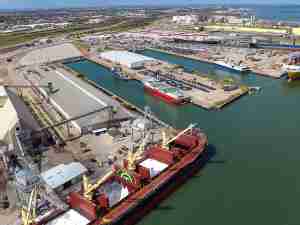The Port of València continues to make progress in its decarbonisation process within the framework of Valenciaport 2030, zero emissions. The Port Authority of Valencia (PAV) has taken two new steps in one of the fundamental projects for the achievement of this objective: the new electrical substation of the Port of Valencia. Specifically, Valenciaport has published the procedure for awarding the contract for the construction of the connection for the electrical substation of the Port of Valencia with a budget of 2,803,030 euros (VAT included). At the same time, the PAV is preparing the specifications for the construction of the electrical substation, which will be published in the next few days, with a base tender budget of 6,539,701.33 euros (VAT included) and a completion period of 24 months.
A new boost to a strategic infrastructure in the objective of electrification of the docks that will allow the ships' engines to be connected to shore power while they are berthed at the port facilities. This substation will serve the different docks of the Port of València, the northern container terminal and the public passenger terminal. The project involves the installation - in two stages - of two transformers with a total apparent power of 60 Mega Voltamperes (30 MVA each), which will enable the voltage received at 132 kV (132,000 volts, or 132 Kilo Volts) to be reduced to 20 kV (20,000 volts, or 20 Kilo Volts), as a preliminary step in bringing this voltage to the different points of the PAV facilities, including the terminal quays to facilitate the connection of ships to the network. In addition, this infrastructure will guarantee significant reductions in emissions and operational costs for ships calling at the port of Valencia. The PAVhas already put out to tender the contract for the site management service and the health and safety coordination of the construction of the transformer substation and the new underground line.
The new electrical substation has the support of the European Commission through the Connecting Europe Facility (CEF) Committee, which is financing the project EALINGWorks Valenciaport: Preparation of the electrical grid of the Port of Valencia for Onshore Powel Supply, to prepare the port's electrical network for the supply of OPS to container ships, ferries and cruise ships in the new terminals of the Port of Valencia, both the new container terminal and the passenger terminal.
A benchmark in decarbonisation
The fight against climate change and the reduction of CO2 emissions and other polluting particles is an essential priority for the PAV. In this context, work is being done to make the reduction of the impact of port activities on the environment compatible with the growth of commercial activity. In this sense, from 2008 to 2019, the carbon footprint of the Port of Valencia has been reduced by 30%, from 3.19 to 2.23 kg of CO2 per tonne handled. In the same period, the activity of Valenciaport grew by 42%, going from 52 million tonnes handled in 2008 to 74 million tonnes handled at the close of the financial year 2019.
This commitment is materialised with specific projects, such as the new electrical substation, to achieve the Valenciaport 2030 goal of zero emissions, two decades ahead of the objectives that Spain, Europe and international organisations have projected for 2050.
Along these lines, the PAV has also initiated projects for the installation of photovoltaic plants in the ports of Valencia and Gandia, the installation of wind turbines for the generation of electrical energy, the replacement of the fleet of vehicles with hybrids and electric vehicles, or projects related to the improvement of energy efficiency, such as the change of lighting in the port areas of Valencia and Sagunto or the improvement of the efficiency of the climate plant in the port of València.










